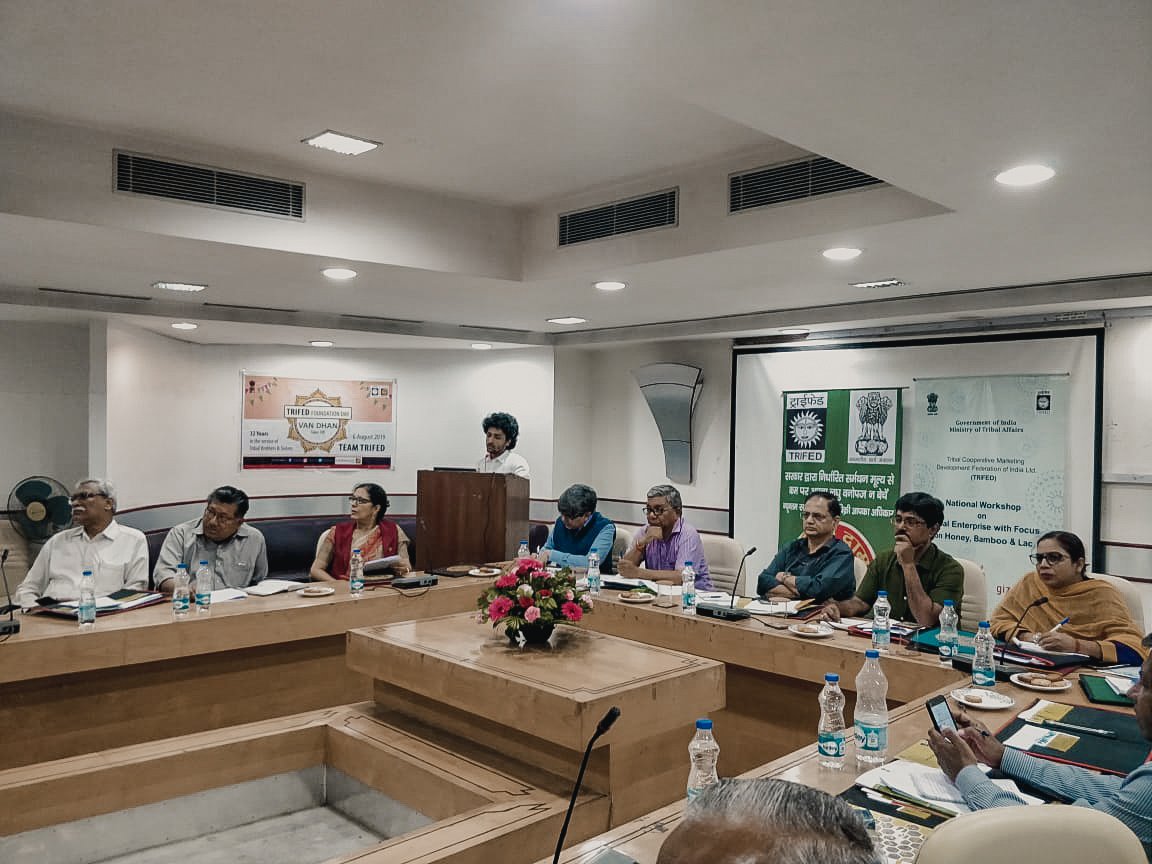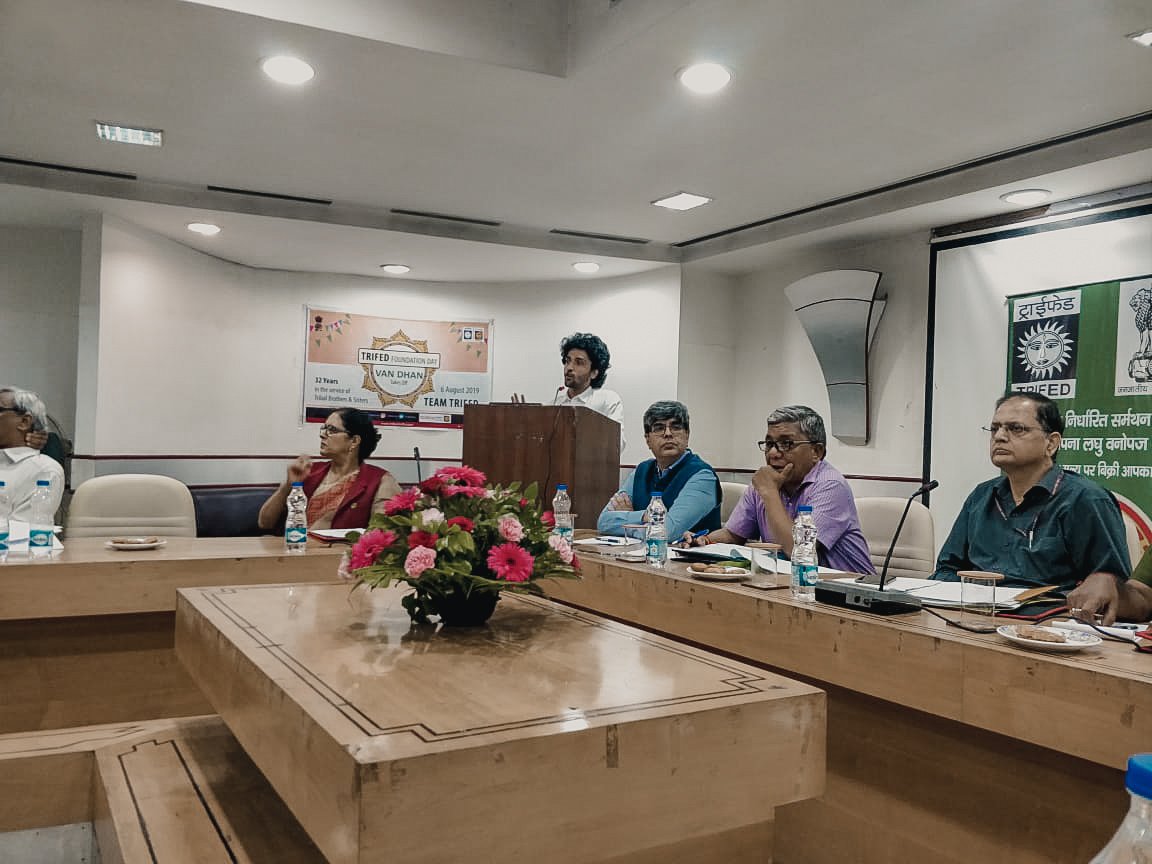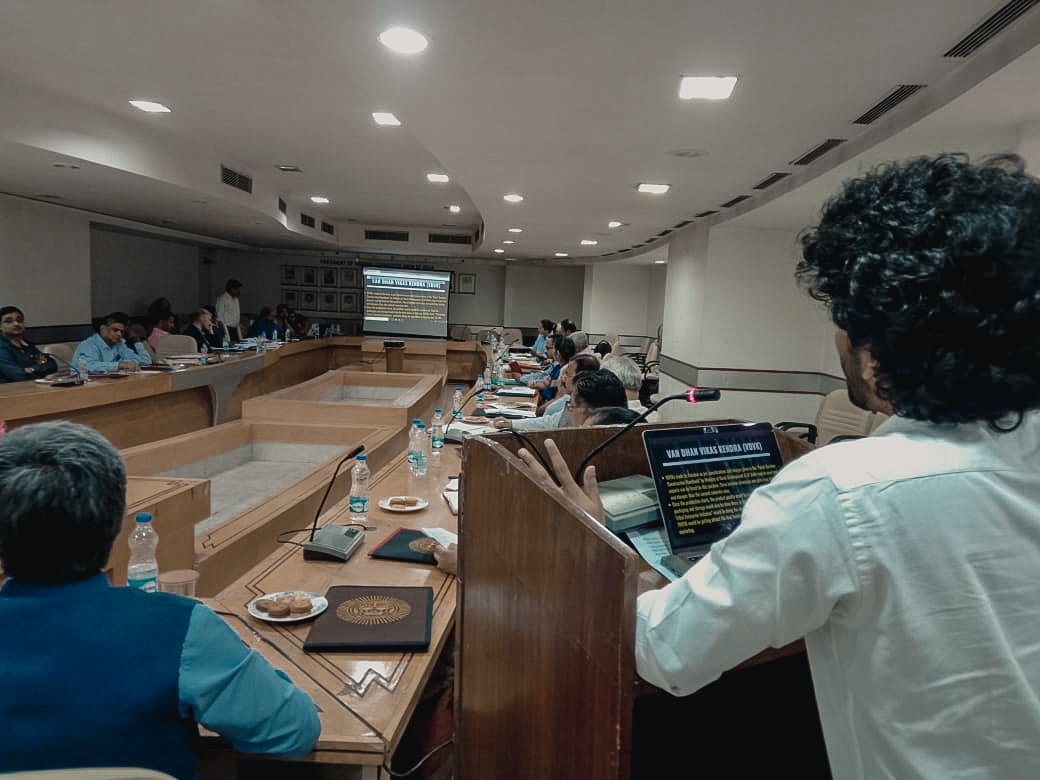



National Workshop on Honey, Lac and Bamboo
The Concept & Research by Mr. Shelly Shaurya:
The global 4P1000 Initiative, established at COP21, aims at increasing soil carbon stocks by 0.4 percent annually through a transition towards sustainable agricultural production and development and promoting farming techniques that combat soil erosion and improve soil health. According to 4P1000, this would halt the increase in greenhouse gas emissions.
The international Initiative “4 per 1000”, launched by France on 1 December 2015 at the COP 21, consists of federating all voluntary stakeholders of the public and private sectors (national governments, local and regional governments, companies, trade organizations, NGOs, research facilities, etc.) under the framework of the Lima- Paris Action Plan (LPAP).
The aim of the initiative is to demonstrate that agriculture, and in particular agricultural soils can play a crucial role where food security and climate change are concerned.
Supported by solid scientific documentation, this initiative invites all partners to state or implement some best practices (e.g. agro-ecology, agroforestry, conservation agriculture, landscape management, etc.) to achieve this goal.
This Initiative is interwoven into the “The Bonn Challenge” under which Germany, India, and many other countries decided to rehabilitate 350 million ha. of degraded lands by 2030 leading to substantial carbon sequestration. The Bonn Challenge, a global initiative launched by Germany and the International Union for Conservation of Nature (IUCN) in 2011 initially decided to have 150 million hectares of deforested and degraded land under restoration by 2020. This target was endorsed by the UN Climate Summit in 2014 and extended to 350 million hectares under restoration by 2030. The Bonn Challenge is not a new global commitment, but rather a practical mean of realizing many existing international commitments, including the CBD (Convention on Biological Diversity) Aichi Target 15, the UNFCCC REDD+ goal, and the Rio+20 land degradation neutral goals.
Experts say that achieving the 350-million-hectare goal could generate US $170 billion per year in net benefits from watershed protection, improved crop yields, and forest products, and could sequester up to 1.7 gigatons of CO2 equivalent annually. Prior to COP 21, 13 countries and a regional alliance had pledged almost 60 million hectares to the Bonn Challenge.
“Paris COP 21 and Global Landscapes Forum 2015 are not just about political commitments. They are about actions and implementation,” says Franzjosef Schafhausen, Director general at Climate Policy, Federal Ministry for Environment, Nature Conservation, Building, and Nuclear Safety, Government of Germany. “Bringing back degraded and deforested lands can help stabilize the climate while sustainably supporting global and local economies.”
India is a signatory of “The Bonn Challenge” and one of the important actors in the “4P1000 Initiative” for Climate Change Mitigation. At the UN Framework Convention on Climate Change (UNFCCC) Conference of Parties (COP) 2015 in Paris, the Government of India made a Bonn Challenge pledge to bring 13 million hectares of degraded land into restoration by 2020 and an additional 8 million hectares by 2030.
According to the IUCN-MOEF&CC Report, known as “The Bonn Challenge and India: Progress on Restoration Efforts Across States and Landscapes Report”, India has brought an area of 9.8 million hectares under restoration since 2011, meaning that work to restore these landscapes is already underway. Of the 9.8 million hectares, 94.4% was contributed by government agencies, while the surveyed NGOs and private companies contributed 3.6% and 2% respectively.
There is a daunting task before the Government and it would not be easy to achieve without the active involvement of TRIFED under the Ministry of Tribal Affairs, Government of India, and without massive participation of the tribal community. It is they who live in forests, dependent on it, and are the direct stakeholders in millions in sheer numbers. TRIFED is mobilizing them to participate in 4P1000 Initiative in order to achieve the Bonn Challenge 2020 & 2030 in India. India poses a special challenge to Bonn Challenge 2020 & 2030 aspirations pertaining to the socio-economic and management issues. And unless address carefully the ambitious target set for itself by IUNC-GOI combine would be impossible to achieve. In India, land degradation and food security has always been the pressing problem and what has not been achieved in the past 70 years will be difficult to achieve by 2030 if new thinking and new solutions are not offered and adhered to. There is a need for a multi-prong strategy and a direct approach to tackle the problem of soil degradation.
Let’s understand this scenario first and also understand what have been the approach of soil treatment in India and the development of wastelands.
TRIFED has generated a research-based report on “Bamboonomics: Aspirations in a Bamboo Regime”. One of the major research findings was the usefulness of Indian bamboo in climate change mitigation, carbon sequestration, and improvement of degraded soils. The report suggested that the Bamboo could be the best option for climate change and land degradation issues in India.
It is seen that India emphasizes more on the “silvicultural approach” as most of the land degradation issues and rehabilitation of wasteland have been tackled by planting the suitable tree species. Even in that, the versatility of the Bamboo has been missed while trees with long gestation period and little economic or ecological value were planted in the degraded soils. Though they could grow in degraded soils, the growth was mostly stunted and the soil improvement takes a long time, and sometimes it gets further drained of nutrients and moisture. It has been seen that the areas where the soil was really bad the plantations failed after an initial blip. The soil did not improve or become resilient by merely planting the hardy species. At some places where water harvesting etc. were successful, partial success was achieved.
Another lacuna that affected the wastelands development in India is no pro-soil approach either in its planning or the guidelines. That is where 4P1000 and use of bio-char, or as TRIFED has established, Bamboo-char or bamboo charcoal comes into the picture. The bamboo charcoal can be an important tool to save the degraded lands in India that according to Governmental estimates are around 38 million hectares.
The treatment of the land (soil) in this way would also generate side-income adding up to better livelihoods. The bio-char especially bamboo char could be a great tool in this effort of achieving “The Bonn Challenge targets in a 4P1000 Initiative regime” especially after the amendment in the Indian Forest Act 1927, categorizing bamboo as a “grass”. With the extremely vast resources of bamboo in India, this is a possibility.
India has one of the richest bamboo resources in the world, second to China in Bamboo production. The annual bamboo production in the country is estimated at 3.23 million tons. According to the Forest Survey of India (FSI), in India bamboo grows in 8.96 million hectares of forest area, which constitutes about 12.8% of the total forest area of the country. A substantial number of tribal communities live in these areas and they cannot be ignored in the climate change mitigation or proofing efforts. The bamboo-charcoal would not only help in soil resilience but its sale would generate extra income for the community. It may be noted that out of 136 genera of bamboo available in India only 10 are commercially viable. So, this bio-char and its commercial value could come from the so-called important commercially unviable bamboos growing in India and the bamboo char from these would make them viable species. Moreover, the cutting of bamboo helps in carbon sequestration as the rhizomes remain in the soil and from them new shoots of bamboo come up and in 5 to 7 years the full stock is resurrected. It has been scientifically proved that the growing and harvesting of bamboo species like Bambusa and Dendrocalamus strictus actually sequester a high amount of carbon as compared to any other tree, or grass in India considering its fast-growing properties. In fact, the standing crop of bamboo does not sequester that much carbon as compared to the growing bamboo clumps. This means that it is better to harvest the bamboo first for unleashing its true carbon sequestering potential. If bamboo clumps are left standing they do not sequester as much carbon as they would if cut and allowed to re-grow. In fact, only bamboo is the species that does more carbon sequestration once it is clear-felled. There are species of bamboo that can grow in degraded soils and they could be planted. The short rotation period of bamboo is very handy in this endeavor. Given an average lifespan of 20-25 years and fast-growing clumps, bamboo can sequester a very large amount of carbon (depending on the cultivation techniques). Then Indian bamboo is invasive in nature and here it scores over Chines Moso bamboo that is monopodial and non-invasive. So, Bamboo covers the area once it is planted. That saves time energy and money as compared to tree plantations. Then bamboo in plantations is maintenance-free. All these give it an edge over others. The Bamboo forests and plantations and the Indian tribal community are going to play a big role in achieving the Bonn Challenge targets in the Indian context by the way of “4P1000 Initiative”.
There is a word of caution and the imperative need for involving Bamboo in the 4P1000 Initiative. The bamboo forests are sensitive ecosystems with a high risk of becoming large GHG emitters. Their protection requires support via international mechanisms to ensure non-destructible management and sustainable income-generating alternatives around them. The efforts undertaken by the TRIFED in spreading this knowledge would be learning from various expertise and experiences around bamboo and tribal livelihoods, enhancing the potential of land to sequester carbon and overall sustainable land management, thus contributing to the Bonn Challenge achieving LDN by 2030. Hence, we need to chalk out good pathways and innovations for collaboration in effectuating the 4P1000 Initiative and achieving LDN and NDCs in India.
In such a scenario, a National Soil Policy is required in India addressing all the issues and factors that could be a guiding force for tackling land degradation.
IUCN’s FLR (Forestry, Landscaping & Resilience) is a good approach in its totality and it can be adhered to in India with some minor variations and also with differential component emphasis. That could differ from situation to situation and case to case. Further, the community sharing has always been wrapped with emerging issues and we need to focus on individual family income. The tragedy of commons (common & community lands) is too well – known to discuss here. The limited effects of JFM Committees & SHGs (Self Help Groups) are to be understood in their socio-economic context also. This individual family approach may generate more involvement of people now than the community participation approach. Once the income of the family is assured things begin to get oriented towards the achievement of the goals.
The aforesaid measures are important to be considered and issues are to be tackled judiciously and only then we can expect the food security and land degradation neutrality will come in India akin to “The Bonn Challenge.”